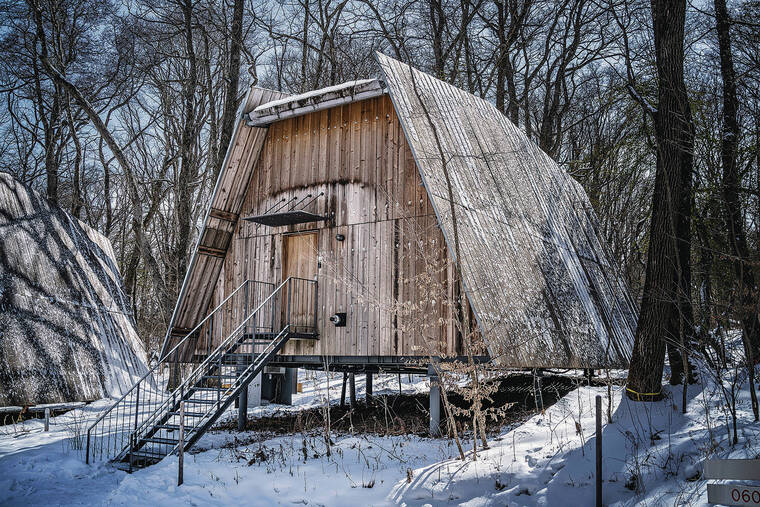Timeshares are back, and cooler than ever

JAMES WHITLOW DELANO / NEW YORK TIMES
Above, Not A Hotel’s Irori, a 2,684-square-foot structure that sleeps eight people.

JAMES WHITLOW DELANO / NEW YORK TIMES
A new model of ownership is allowing middle-class families and wealthy vacationers alike to buy a piece of alluring properties. Above, a cottage at Sanu Bee in Kita-Karuizawa.


In the foothills of Mount Asama, one of Japan’s most active volcanoes, jagged lava formations dot the landscape — remnants of a 1783 eruption that swallowed villages and permanently scarred the land. A nearby park pocked with dark volcanic rock is called Onioshidashien, or Expelling Demons.
Nearby, a crop of angular polyhedrons appeared last year, joining the lava deposits in this forested region about 90 miles northwest of central Tokyo. These new objects arrived with skylights and saunas.
The Mount Asama area, which one local tourism site calls “one of the best spots in Japan to witness the threat of nature,” may seem an unlikely place for a showcase of modern design. But these geometric vacation homes mark the return of a trend that went out of fashion in Japan’s post-1980s economic decline: timeshares.
Built on platforms, the 14 Moss cabins, designed by architect Kotaro Anzai for timeshare startup Sanu, have floor-to-ceiling windows to bring in views of the surrounding forest of Japanese maple, elm, magnolia and Mizunara oak. At 516 square feet, they accommodate four guests. Amenities include pellet stoves, wine cellars and, in some cases, private saunas. Apart from their unusual geometric design, the cabins’ main attraction may be their furniture, which is made entirely from Japanese woods.
A short drive away, Sanu’s cluster of slightly larger, A-frame-style cabins also feature Japanese woods. Inspired by honeycombs, the Bee bungalows have sleeping nooks with two semidouble beds framed by semicircular, slatted interior walls. There’s plenty of light from large windows under the 13-foot ceilings, and some decks have saunas.
This new generation of timeshares is attracting remote workers, co-owners and investors ranging from middle-class families to global celebrities. They offer a fractional ownership system new to Japan — part of the redrawing of a tourism and leisure industry that has been shaken up by the rise of hybrid work and a surge of inbound visitors.
Don't miss out on what's happening!
Stay in touch with breaking news, as it happens, conveniently in your email inbox. It's FREE!
“Owning a cottage can be very expensive in Japan, but we can overcome that through sharing,” said Gen Fukushima, 38, CEO of Sanu, which began operations in 2021. “We want to give people the chance to live and work remotely in a natural environment.”
Sanu offers two basic services: Subscribers can pay a monthly fee of 55,000 yen (about $370) for up to seven nights at more than 30 sites across Japan. They can also buy shares of the properties for 12 nights a year starting at about 4 million yen.
Timeshares were a popular concept in Japan’s high-growth heyday and, more recently, before the yen lost about one-third of its peak value. The country’s timeshare market developed in the 1990s and early 2000s, centered on high-rise beachfront properties in Hawaii run by major hotel chains, as well as some domestic “resort clubs.” The yen’s drop has hit hard for the roughly 100,000 Japanese who own timeshares in Hawaii, with many struggling to sell their units because of expensive fees in dollars.
Despite all this, Yasushi Asami, an urban engineering professor at the University of Tokyo, said Japanese consumers are again warming to properties that offer flexibility as the app-based sharing economy gains traction in Japan. “In terms of the real estate market, it used to be popular to purchase resort condominiums or villas, but recently, there are risks to owning them,” Asami said. “So I think timeshare and accommodation types are becoming more popular.”
Membership resort hotels, led by brands such as Tokyo’s Prince Hotels, are expanding their offerings. Hilton Grand Vacations, which operates nearly 200 timeshare resorts globally, is opening a complex in Kyoto, its third in Japan.
At the other end of the spectrum are smaller-scale properties with heritage or high style. Some entrepreneurs are making use of Japan’s millions of abandoned houses by turning them into shared accommodation. Kessaku, a startup founded in 2024, wants to protect heritage houses by preserving them as timeshares. Starting from $15, investors can acquire fractional ownership and use of these homes.
Then there’s the high end. In the Mount Asama region, a startup called Not a Hotel has opened luxury accommodations such as Irori, a 2,684-square-foot structure that sleeps eight and evokes the clean lines of Frank Lloyd Wright. The glass-walled house centers on its irori hearth, a dining space in traditional farmhouses. Wings lead off to bedrooms, a sauna overlooking a terrace and garden, and a bath fed by hot springs.
Buoyed by the cheap yen and surging inbound tourism, Not a Hotel says it has amassed contracts valued at 37.6 billion yen from nearly 750 co-owners since its establishment in 2020. Company founder and CEO Shinji Hamauzu said the fractional ownership model allows clients to buy only as much as they need — one-twelfth of a property allows 30 nights.
“Many affluent people today are able to work from wherever, and they like to travel around rather than commit to a single place every year,” Hamauzu said. “Every time we expand our properties, we give owners new places to go.”
© 2025 The New York Times Company



